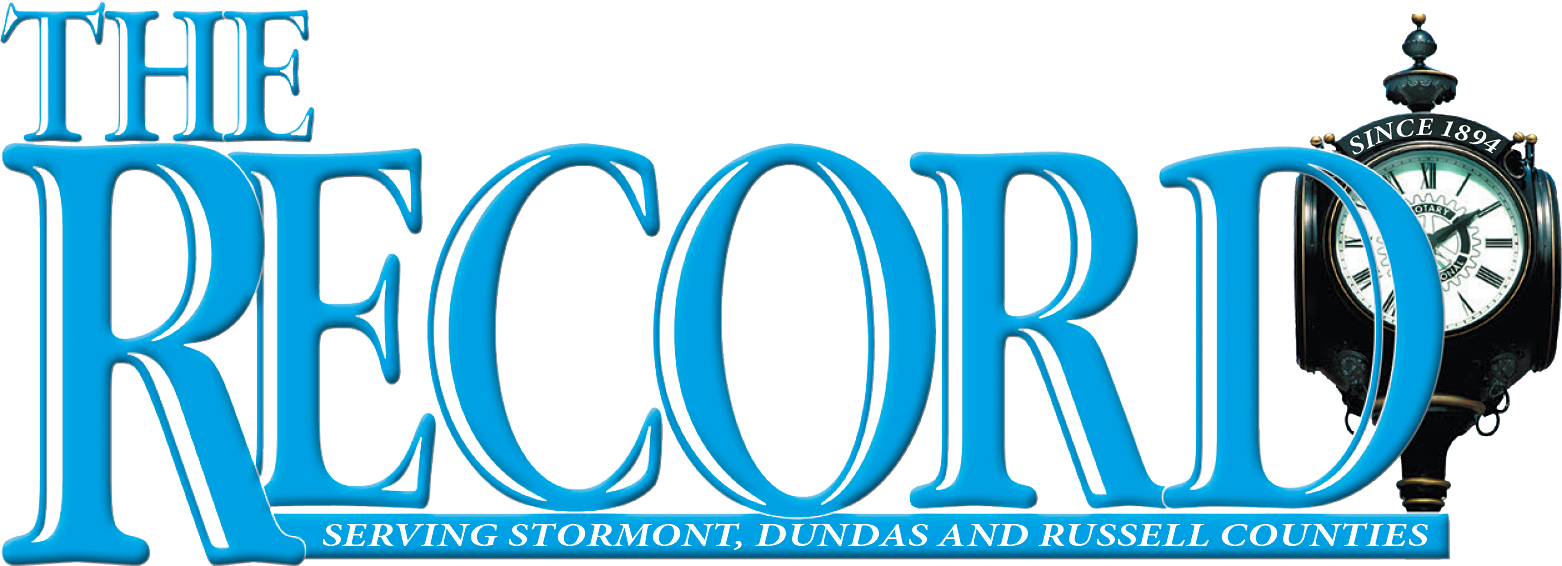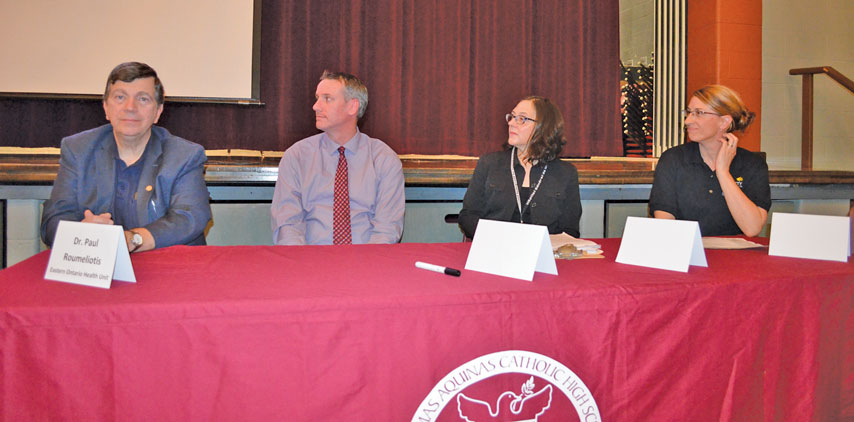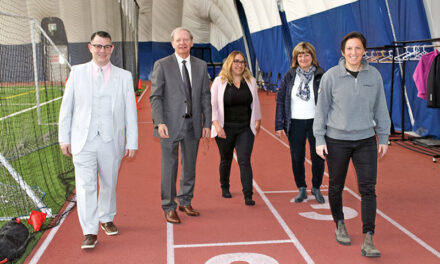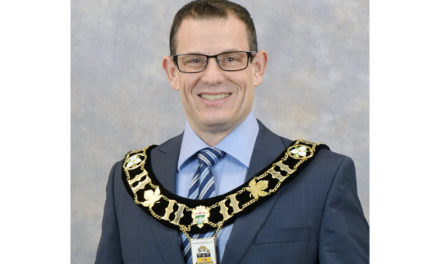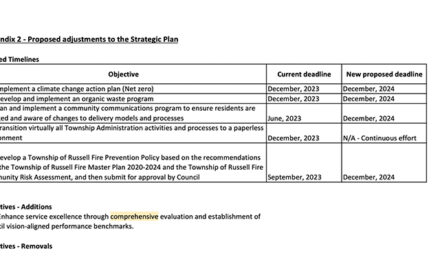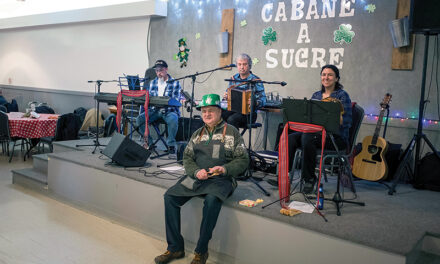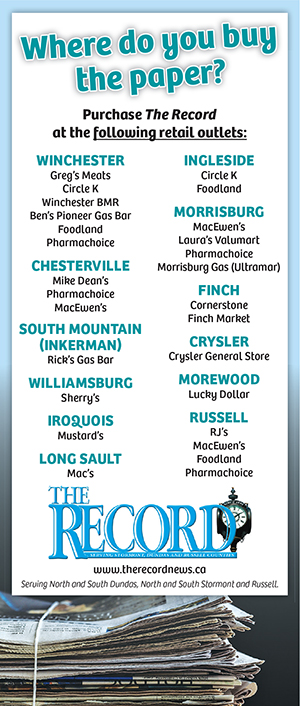Fentanyl advice from the pros
EOHU’s Medical Officer of Health Dr. Paul Roumeliotis, OPP officer Dean Canham, Hawkesbury General Hospital’s Wenda McOuat, Nikolas Hotte of EOHU (not shown), and Cher Goulet of the Kin Club’s Reality Tour, made presentations about fentanyl use at STACHS on Thurs., May 11. Vetter photo
Candice Vetter
Villager Staff
RUSSELL — A panel composed of police and health professionals addressed parents about the rise of the drug fentanyl, on Thurs., May 11, at St. Thomas Aquinas Catholic High School in Russell.
The Eastern Ontario Health Unit’s Medical Officer of Health Dr. Paul Roumeliotis, OPP officer Dean Canham, Hawkesbury General Hospital’s Wenda McOuat, Nikolas Hotte of EOHU, and Cher Goulet of the Kin Club’s Reality Tour, made presentations about fentanyl use, its dangers and how to cope with potential exposure to the highly-addictive and dangerous drug. Several presentations have been held in area schools in May, in cooperation with EOHU, the OPP and HGH, as well as local school boards.
Hotte showed slides which dramatically illustrated the difference between a fatal dose of heroin and a fatal dose of fentanyl. The reason fentanyl is responsible for overdoses, including fatal overdoses, is that it is being added to other drugs, usually sold in pill form, which may look like illegal recreational drugs such as ecstasy, or like legal prescription drugs. “They have very good pill pressers,” said Hotte. “There are no safe street drugs. The only drugs you should use are medicines prescribed to you and purchased from a pharmacy.”
Fentanyl is often added to counterfeit or street drugs to increase the addictive quality, but because it is such a concentrated opioid a tiny fraction of a tiny piece can be enough to stop breathing and cause death and there is no way to know if the drug is present.
Officer Canham pointed out that Cornwall police have seized pills which tested positive for fentanyl but he said an overdose problem had not been noted in Eastern Ontario yet.
Dr. Roumeliotis said Eastern Ontario had a high number of emergency room visits due to analgesics and opioids like oxycontin
from 2010 to 2013, but
that has decreased. Oxycodone/oxycontin have been taken off the market, but as Hotte pointed out, hydromorphone use is up. “Why don’t we just take drugs off the market?” he asked. “We do that and another drug moves in.” That new drug is often worse, as is the case with fentanyl.
Various charts showed the ages when students are most vulnerable to drug experimentation and the most open to advice about safety. For students in Grades 6, 7 and 8 that is a good time to push safety, and Grades 9 to 12 is when there are big upticks in all kinds of substance use, including recreational drugs, alcohol and tobacco. “It’s a time of experimentation,” said Roumeliotis. Panelists pointed out something that seemed to surprise some of the approximately 50 parents attending. “Abstinence isn’t for everyone.”
He said some youth will want to try these drugs, and he said in the past they advised “safer use,” that those who were going to experiment try very small quantities. Since adulteration with fentanyl, however, which is so deadly in such tiny doses, there is no safe way to try pills.
Said Canham, “The big problem is that kids aren’t going out and buying fentanyl – they’re buying speed, Xanax, whatever, but there is fentanyl in it.”
Focusing on the issue of harm reduction for teens who are using alcohol or drugs already, it is important to focus on the child’s strengths, to reinforce good behaviour, to encourage positive social activities (in particular, don’t take away healthy activities as punishment), and don’t be afraid to ask for help.
Panelists encouraged watching for signs of drug use, particularly eyes, and talking openly with kids, saying, “I don’t accept you using drugs, but I want you home safe,” and not getting angry if your child calls needing your help or a ride home.
Safer use also included: not using drugs alone, finding a safe place and staying there (not with strangers, not out on the street or in the middle of the woods), knowing limits and staying in them, avoiding pill use, not taking any random drug, having a sober buddy, limiting drugs or alcohol you carry (which also helps avoid serious criminal charges), not sharing paraphernalia, questioning whether use is affecting quality of life, and calling 911 if something doesn’t feel right. They also pointed out a recent change in drug laws, as now a person cannot be prosecuted if helping someone. So if you use a drug, and a friend is in medical distress, you cannot be prosecuted for drug use or possession because you took that friend to the hospital. Officials are hoping this will help prevent overdose situations that could have been treated.
Roumeliotis discussed naloxone, the anti-OD treatment, saying it works within two to three minutes, lasts about two to three hours, and may need more than one dose. “Call 911, stay with them, and keep them in the recovery position until an ambulance arrives.” Naloxone is available through EOHU and many pharmacies, and is recommended for drug users and their parents.
Wenda McOuat of HGH described mental health and addiction services available through the hospital and its satellite offices. She said not everybody is ready for abstinence, but there are therapies for how to stay safe, to establish goals, and access to psychiatrists, social workers, occupational therapists, addictions team, gambling therapy, relapse prevention (mindfulness), cyber psychology using virtual reality (which is proving effective and well-received with young people), and methadone treatement.
Goulet briefly plugged the Reality Tour, which is designed for parents and kids to attend together. The presenters partner with Harvest House, bringing four recovering addicts in to talk to the audience.
